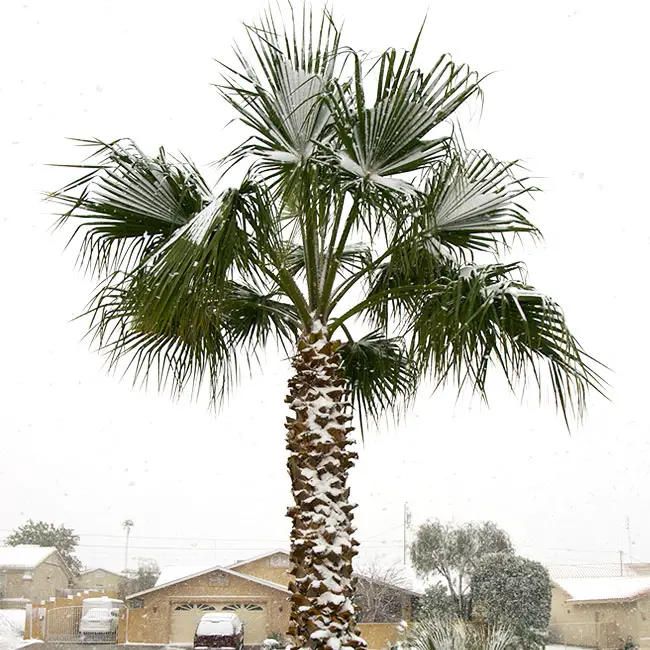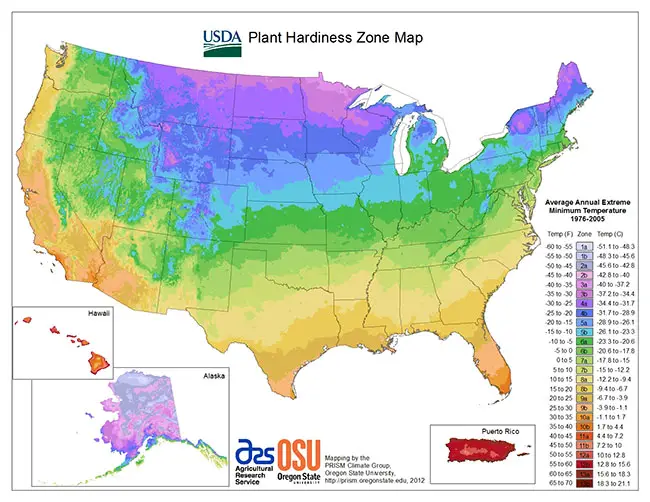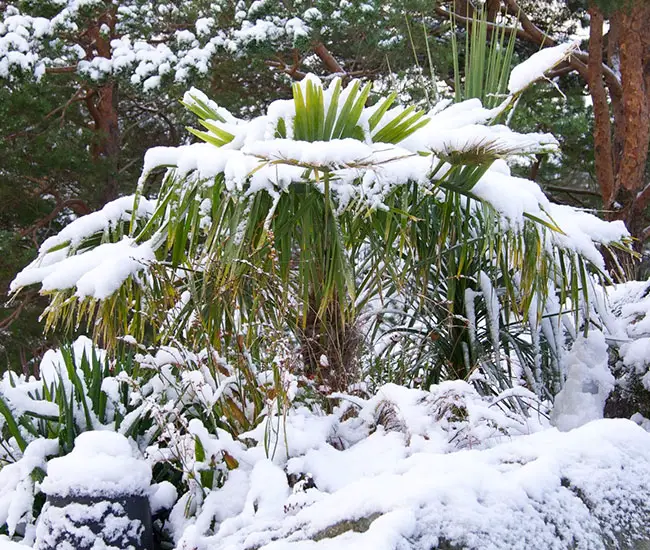
While palm trees are often associated with tropical locales, there are varieties that can thrive in subtropical and even temperate climates. Surprisingly, some palm trees can withstand subzero temperatures and heavy snowfall.
To successfully cultivate palm trees in cold climates, it’s crucial to select a cold-tolerant species that can endure the harsh winter conditions in your area. Additionally, harnessing the microclimate of your property can significantly expand the range of palm species you can grow.
Factors like acclimatization and soil conditions play pivotal roles in how quickly your palm establishes itself in its new environment. If you’re in Zone 8, growing palm trees should be a manageable endeavor if you follow the tips below.
1. Determine Your Hardiness Zone

North America is divided into 11 hardiness zones, each with an average winter temperature that is 10 degrees Fahrenheit warmer than the adjacent zone.
The latest USDA Zone Map, developed in 2012 by Oregon State University (OSU) and the USDA’s Agricultural Research Service (ARS), showcases these zones.
When compared to the 1990 version of the map, you’ll notice shifts in zone boundaries, with the new map generally reflecting zones that are half a zone (5 degrees Fahrenheit) warmer.
To identify your specific hardiness zone, visit the USDA website and enter your zip code. Additionally, reviewing past winter records for your area can help you pinpoint any microclimates—small areas with slightly different climates than the overall regional climate.
Knowing your hardiness zone is crucial for narrowing down your palm tree selection.
2. Choose the Right Palm Tree
Not all palm trees can withstand cold temperatures in the same way. Due to their origins in various countries, palm trees exhibit differing levels of cold tolerance, often referred to as “cold hardiness.”
The most reliable method to determine a palm tree’s ability to endure low temperatures and humidity levels is to consider its natural habitat.
Palm trees have adapted to their native environments over millions of years, allowing some species to develop greater cold hardiness than others.
For instance, palm trees native to the Mediterranean region tend to be more cold-hardy than those originating from warmer climates like Fiji.
When selecting a palm tree for your specific climate, it’s essential to assess its cold hardiness. You can explore my post on 20 cold-hardy palms capable of surviving snow and freezing temperatures.
While most of these palms thrive in Zone 8, there are exceptionally cold-tolerant varieties that can even endure Zone 7 conditions.
The disparity between cold-hardy palms and those favoring warmth is quite significant. For example, the Coconut palm can tolerate cold down to 40°F, while the Needle Palm, recognized as the hardiest palm tree globally, can endure temperatures as low as -5°F and has been known to survive temperatures as frigid as -24°F.
3. Use the Microclimate of Your Property To Your Advantage
Every yard contains microclimates where temperatures can be one-half to a full zone warmer or colder than the surrounding area.
In most gardens, variations in factors such as drainage, soil conditions, light exposure, and other features occur over relatively short distances. To make the most of this, you can categorize your property into distinct microclimate zones.
Identify sheltered areas shielded from wind, determine the compass orientation of your house, note the lowest and highest elevations, locate tall evergreen shrubs and trees, distinguish between full-sun and shaded spots, consider the presence of water features, and so on.
A simple way to identify warmer microclimates is by observing frost patterns. For more precise data, strategically place inexpensive thermometers, readily available at hardware stores, throughout your yard at about 1-2 feet above the ground.
This will reveal temperature variations during cold winter nights. In colder climates, microclimates can make a substantial difference, enabling you to cultivate up to 400 palm species compared to just 50.
Protecting palm trees from the chilling effects of winter winds can be achieved by positioning them behind dense shrubs, windbreaks, or within sheltered courtyards.
Other warmer spots include areas near buildings, fences, paved surfaces, beneath overhanging porches, close to water features, under the canopy of taller trees, or on hillsides.
Furthermore, palms benefit from the warmth retained by stone or brick walls and other structures that absorb heat throughout the day and release it at night, keeping the palms cozy.
4. Acclimate Your Palm Tree
The popularity of palm trees has surged in recent years, leading many palm tree nurseries to cultivate thousands of palms to meet the growing demand.
Often, these nurseries grow various palm species in the same location. As most of these nurseries are situated in warm climates, the palm trees they produce rarely encounter temperatures below freezing.
Consequently, if you purchase a cold-hardy palm that has never been exposed to cold weather and plant it in a colder climate, it is unlikely to survive.
Cold-hardy palms require acclimatization to better endure cold weather. This process, also known as acclimation, must be executed gradually to prevent the palm from going into a state of shock.
While some nurseries take the time to acclimate cold-hardy palms before selling them to customers in northern regions, others may not prioritize this step. This highlights the importance of purchasing palms from reputable nurseries that prioritize the quality of their trees over profit.
To acclimate a palm tree to cold conditions, you should slowly expose it to lower temperatures while providing freeze protection. Various winterization techniques are available, but I recommend starting with the basics.
5. Give Palms Plenty of Time to Grow Strong Roots
Mature palm trees have a greater chance of surviving cold weather because they possess thicker trunks, more leaves to shield the crucial bud, and more extensive root systems.
Some cold-hardy palms even develop a protective husk, an outer layer of fiber that shields their trunk from the cold. Young palms, on the other hand, have thinner bark and smaller root systems, making them less resilient in the face of cold weather.
It’s essential to consider that when transplanting a mature palm to a new location, failing to provide sufficient time for the development of a robust root system before the onset of cold weather can jeopardize its survival.
This is why I recommend planting palms in the spring, allowing them ample time to establish their root systems.
6. Provide Great Soil
While many palm tree species can adapt to various soil types, they tend to thrive in well-drained, organically rich soils. Some palm trees can even flourish in clay soil, provided that organic matter is incorporated, and drainage remains efficient.
Clay soil offers the added advantage of heat retention, which helps regulate temperatures. To determine your soil type, you can either send a soil sample for professional testing or perform a simple “ball test.” Dig up some soil and attempt to form a ball with it.
Ideal soil will produce a crumbly ball due to the presence of various particle sizes, including sand, clay, and organic matter. If your soil consists mostly of clay, it will result in a sticky mass, while sandy soil will not form a ball at all.
Clay soil excels at retaining water but has slow drainage, limiting oxygen penetration to the root zone. Conversely, sandy soil drains excessively, causing nutrients to leach away after each rainfall.
To enhance sandy or clay soils, incorporate ample organic matter such as peat moss and organic humus. For those unfamiliar with the term, humus is essentially a dark, organic, mostly carbon-based material that has reached a stable state of decomposition.
These materials are readily available at local gardening stores and serve to enrich the soil with nutrients while promoting water retention and drainage.
7. Improve The Drainage
Evaluate the drainage capabilities of your soil by digging a 12-inch hole and filling it with water. After it has drained, refill it ten hours later and observe how long it takes to drain completely.
In well-draining soil, the water should dissipate in about two hours. If it takes longer, consider improving drainage before planting, as prolonged standing water can lead to root rot and the demise of your palm tree.
Several methods can enhance drainage, including adding construction sand and organic material to the soil, placing rocks at the hole’s bottom, or creating holes in the base to loosen the soil.
The most involved option is installing a drainage pipe to redirect excess water away from the plant, which may necessitate significant digging.
8. Fertilize Your Palm Tree
The health of your palm tree is another crucial factor for successful growth, especially when it comes to its ability to withstand cold winter temperatures. Palms experience various phases of acclimation and de-acclimation throughout the year, making it vital to provide them with sufficient nutrients during the warmer months.
I always recommend using a high-quality slow-release fertilizer, as opposed to a cheaper alternative that can be easily washed away by rain. Slow-release fertilizers allow palm trees ample time during the warmer seasons to absorb essential nutrients and prepare for the winter ahead.
Research has shown that fertilizing palms in the middle of winter has no significant effect on their survival rate. As temperatures drop, palms enter a hibernation phase characterized by a slowdown in their photosynthesis process and reduced nutrient absorption.
9. Improve Water Intake
Drought stress can be a significant challenge for palms, particularly during their establishment phase. Drought stress weakens the palm and can impact its ability to endure cold weather. In addition to employing deep watering techniques, there’s another clever trick you can utilize.
When planting a palm, consider installing a 4-inch plastic drain pipe adjacent to the root ball. These drain pipes, typically used for basement waterproofing, feature holes that collect water and direct it to a sump pump.
Position the pipe slightly above the mulch at the top and ensure it extends all the way to the bottom of the planting hole. This setup allows you to deliver water directly to the palm’s roots.
This method proves especially valuable during frigid winters when frozen soil makes traditional watering impossible. You can even use warm water to provide added warmth to the palm’s roots.
Be sure to cap the top of the drain pipe to prevent winter air from reaching the roots and to minimize moisture loss during scorching summer days.
10. Palm Cold Protection

Cold protection for palm trees can be crucial, especially for newly planted ones. It typically takes palm trees three full growing seasons to become fully established, and in heavy clay soil, this process may take even longer. During this adjustment period, palms are highly sensitive to cold, drought, and various stressors.
I highly recommend implementing cold protection during the first three years of a palm tree’s establishment and during sudden cold snaps thereafter. There are several techniques available to protect your palm, and here are some of the simplest and most effective ones:
Mulching: An easy approach is to apply 6-12 inches of mulch around the base of the palm. This layer of mulch serves as insulation, protecting the roots and the lower trunk from freezing temperatures.
Christmas lights: Wrapping Christmas lights around the trunk of the palm not only adds a festive touch but also raises the temperature around the tree by about 2-3°F during cold winter nights. Keep in mind that windy conditions can diminish the effectiveness of this method.
Antidesiccant spay: One of the biggest challenges during cold winter days is water loss from the foliage, especially when freezing temperatures coincide with bright sunshine and chilly winds. An antidesiccant spray creates a protective, waxy layer that helps prevent water loss from the palm tree’s foliage.
Heavy watering: Prior to a cold snap, water the soil around the palm tree generously. This practice warms up the roots, as moist soil retains heat more effectively than dry soil. Using lukewarm water instead of cold water can provide even more warmth to the roots.
Mummy wrapping: This method requires a bit more effort. Use a synthetic blanket that doesn’t trap moisture and wrap it around the palm’s trunk and as much foliage as possible without causing damage. Secure it with duct tape, and you can even add Christmas lights for additional warmth.
It’s important to note that exposing palm trees to some cold weather is beneficial as it increases their cold hardiness. Therefore, you don’t need to rush to protect them at the first sign of winter.
In Conclusion
With the tips provided above, you can successfully grow cold-hardy palms in Zone 8. By leveraging the microclimate of your property and employing cold protection techniques, you can even extend your palm-growing capabilities to a zone higher than your current one.
This means that if you live in Zone 7, you can now cultivate palm species that are typically hardy only to Zone 8.
Related articles:
- Palm Tree Cold Protection
- How to Save Cold-Damaged Palm Tree
- Importance of Microclimate When Choosing Cold Hardy Palms
- Top 10 Cold Hardy Palm Trees

We have several Queen Palm trees in Louisiana and I wrapped their bases with plastic & put clear Christmas lights on each. However, all the leaves turned brown. I had the leaves cut that fell straight down along side the tree. Will these trees live without any leaves? Where do you spray the copper treatment?
I have more trachikarpus palms planted in the garden …. in winter if I drop the temperature below minus 15 degrees I protect them nylon … usually it is twenty days … otherwise without problems and protection they can stand up to minus 15 degrees … when there are bigger minuses like those in the year 2016 when the temperature dropped and below minus 24 degrees I put their lamps and heaters underneath nylon …if you want, I’ll send you pictures
On a weeping type palm tree, can you cut off the dead tips without harming the rest of the leaf?